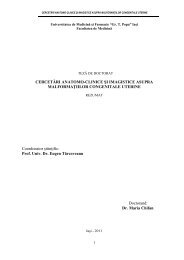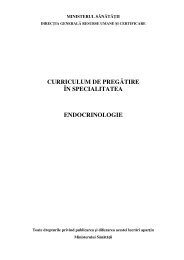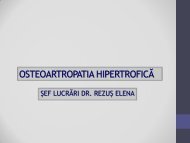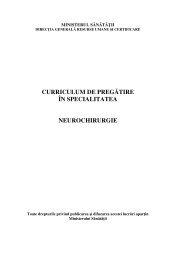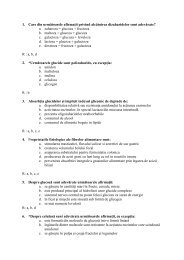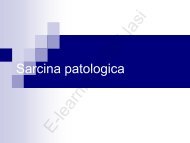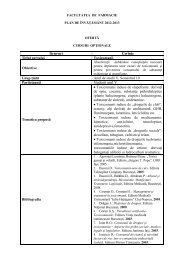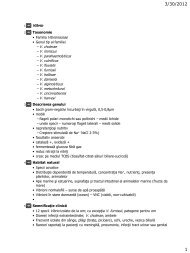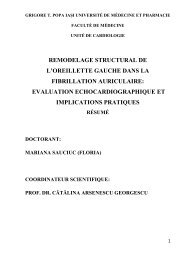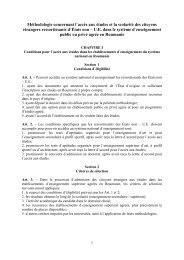Subject Surgery and Pediatrics Orthopedics MG5.2.10 ... - Gr.T. Popa
Subject Surgery and Pediatrics Orthopedics MG5.2.10 ... - Gr.T. Popa
Subject Surgery and Pediatrics Orthopedics MG5.2.10 ... - Gr.T. Popa
Create successful ePaper yourself
Turn your PDF publications into a flip-book with our unique Google optimized e-Paper software.
<strong>Subject</strong> <strong>Surgery</strong> <strong>and</strong> <strong>Pediatrics</strong> <strong>Orthopedics</strong><br />
<strong>MG5.2.10</strong> <strong>Surgery</strong> <strong>and</strong> <strong>Pediatrics</strong> <strong>Orthopedics</strong><br />
Lectures (20 hours)<br />
1. <strong>Pediatrics</strong> surgery – specific areas. Congenital anomalies. Value <strong>and</strong> consequences of<br />
antenatal diagnosis. General surgery pathology. (2 hours)<br />
2. Pulmonary malformations. Surgical diaphragmatic hernia. Esophagus malformation.<br />
Neonatal congenital occlusions. Malformations of the abdominal wall. (2 hours)<br />
3. Hypertrophic pyloric stenosis. Intestinal invagination. Acute appendicitis. Congenital<br />
megacolon ( 2 hours)<br />
4. Urologic emergencies. Intersexuality states. Epispadias. Hypospadias. Testicle absence in<br />
the scrotum. (2 hours)<br />
5. Generalities on the child tumors. Teratomas. Nephroblastom. Neuroblastom.<br />
Hemangiomas. Vascular malformations ( 2 hours)<br />
6. acute osteomyelitis. Acute osteoarthritis of the newly born. Acute osteit. Subacute<br />
osteomyelitis. Acute arthritis. Chronic osteomyelitis. Arthrogryposis. Motor infirmity of cerebral<br />
origin. Constrictive rings disease. (2 hours)<br />
7. Primitive ischemic osteonecrosis. Osteogenesis imperfecta. Unicameral bone cyst.<br />
Aneurysmal bone cyst. Bone osteom. Euzinofile granulom. Osteosarcome. Ewing sarcoma.<br />
Osteogenic exostoses. (2 hours)<br />
8. Arthro‐sinovial cysts. Cranial dysraphism. Posterior spinal dysraphism. Scolioses.<br />
Ciphoses. Congenital muscular torticolis. Pectus excavatum. Pectus carinatum. (2 hours)<br />
9. Sprengel disease. Sindactilia. Polydactilia. Transitory acute synovitis. Epifiziolosis.<br />
Sprained malformation of the hip (2 hours).<br />
10. Postinjectional retraction of the quadriceps. Axial deviations in the frontal plane of the<br />
knee. Vicious walking attitudes. Postural deformations of the leg. Congenital equino‐varus leg.<br />
Congenital talus valgus leg. Congenital metatarsus adductus. Static flat foot. Peculiarities of the<br />
bone at child. Peculiarities of child fractures. Obstetrical traumatisms. Silverman syndrome.<br />
Child burns. ( 2 hours)
Practice (22 hours)<br />
1.Physical examination of the new born for finding any apparent malformations<br />
2. Checking the permeability of the digestive tube at birth<br />
3. Sectioning the lingual frenule<br />
4. Transport conditions <strong>and</strong> necessary care during transport for the patient with esophageal<br />
atresia or neonatal to the pediatric center<br />
5. pleural punction <strong>and</strong> pleurotomia on Pezzer’s sonde<br />
6. palpating the pyloric olive<br />
7.discovering an abdominal tumor<br />
8. physical signs of appendicitis in the grown child<br />
9. nursing maneuver at new borns <strong>and</strong> suckling babies with congenital megacolon<br />
10. value of rectal tushe in finding surgical afflictions in children<br />
11. reduction <strong>and</strong> provisory fixation of anal mucus prolaps<br />
12. Taxis maneuver for reduction <strong>and</strong> maintaining inguinal hernia or inguinal‐scrot strangulation<br />
14. paraphimosis reduction<br />
15. Bladder sounder<br />
16. Examining inguinal‐scrot area to establish testicles’ presence<br />
17. Rachidian punction<br />
18. Articular punction<br />
19. Reduction of the painful pronation<br />
20. Taking care of children immobilized in plaster corset<br />
21. Treatment of obstetric fractures of clavicule <strong>and</strong> femur<br />
22. Immobilizing children’s fractures<br />
23. Ortolani maneuver <strong>and</strong> Barlow test for finding luxant malformation of the hip in neonatal<br />
period.<br />
24. Clinical symptomology of congenital hip luxation at suckling babies <strong>and</strong> toddlers<br />
25. Contentive treatment in abduction for congenital lax hip.<br />
26. Correction maneuvers <strong>and</strong> fixating adhesive b<strong>and</strong> on congenital uneven equino‐varus leg.
Suject: Internal Medicine – Diabetes, Metabolism <strong>and</strong> Nutrition Diseases<br />
MG5.1.1 Internal Medicine – Diabetes, Metabolism <strong>and</strong> Nutrition Diseases<br />
Cours (12 hours)<br />
1. Diabetes mellitus:<br />
i. definition<br />
ii. the grounds of the clinical diagnosis<br />
iii.<br />
classification<br />
the lab diagnosis criteria ( genetic, immunologic, biochemical markers,)<br />
2.<br />
history)<br />
Type 1 diabetes mellitus (etiopathogeny, physiopathology, symptoms, natural<br />
3.<br />
history)<br />
Type 2 diabetes mellitus (etiopathogeny, physiopathology, symptoms, natural<br />
4. The criteria of a good metablic control<br />
5. The management of diabetes mellitus (the role of the doctor, the role of the pacient,<br />
the genetic advice)<br />
6. Diet <strong>and</strong> physical exercise<br />
7. Type 1 diabetes mellitus treatment (therapeutical means, methods, pratical<br />
strategies, side effects)<br />
8. Type 2 diabetes mellitus treatment (oral anti-diabetes medication, action<br />
mechanisms, therapeutical strategies, insulinotherapy in type 2 diabetes mellitus)<br />
9. Special situations: pregnancy <strong>and</strong> diabetes mellitus, surgical interventions <strong>and</strong><br />
diabetes mellitus<br />
10. Acute complications of diabetes mellitus:<br />
i.<br />
treatment)<br />
hypoglycemy in the diabetic patient (physiopathology diagnosis,<br />
ii. diabetes ketosis <strong>and</strong> keto acidosis (physiopathology diagnosis, treatment)<br />
iii.<br />
treatment)<br />
hyperosmolar hypoglycemic coma (physiopathology diagnosis,<br />
iv. the therapy approach of other emergencies of the diabetic patient<br />
(infections, alcoholic keto acidosis, lactic acidosis)<br />
11. Chronic complications of diabetes mellitus:<br />
i. mechanisms<br />
ii. diagnosis criteria for:
1.<br />
retinopathy)<br />
dabetic microangiopathy (diabetic nephropathy, diabetic<br />
2. dabetic macroangiopathy (particularities)<br />
3. diabetic (peripheric <strong>and</strong> vegetative) neuropathy, the management<br />
of diabetes mellitus chronic complications<br />
12. Obesity:<br />
i. evaluation of the weight status<br />
ii. obesity classification<br />
iii. obesity complications<br />
iv. obesity treatment<br />
13. Dyslipidemias:<br />
i. definition <strong>and</strong> classification<br />
ii. clinical <strong>and</strong> paraclinical diagnosis<br />
iii. screening <strong>and</strong> treatment<br />
14. The metablic syndrome X:<br />
i. physiopathology<br />
ii. diagnosis critria<br />
iii. therapeutical approach<br />
Practical activities (30 hours)<br />
1. Practical modalities of integrating the diabetes mellitus diagnosis<br />
2. The clinical exam of the diabetic patient<br />
3. The value <strong>and</strong> interpretation of the lab parameters<br />
4. The clinical management of diabetes mellitus: objectives <strong>and</strong> general strategy<br />
5. The management of hyperglycemia:<br />
i.<br />
patients<br />
opimizing the life style; srategies of elaborating the diet for the diabetic<br />
ii. insulinotherapy: commercial products, the technique of insuline<br />
administration, therapeutic strategies, indications, counterindications, side effects; clinical cases<br />
iii. oral anti diabetes medication: the principles of oral therapy, tpes of oral<br />
medication, indicatons, counterindications, administring methods, medcation interferences, side<br />
effects; clinical cases<br />
iv. estimation of therapy efficiency<br />
v. specific education in diabetes mellitus
6. The management of diabetes mellitus in elderly pacients, children <strong>and</strong> teenagers;<br />
diabetes <strong>and</strong> pregnancy, the surgery patient<br />
7. The diabetic ketosis <strong>and</strong> keto acidosis diagnosis<br />
8. The dianosis of hypoglycemy in the diabetic patient<br />
9. The management of acute complications of diabetes mellitus; clinical cases<br />
10. The diagnosis of dabetic microangiopathy<br />
11. The diagnosis of dabetic macroangiopathy; estimarea riscului cardiovascular<br />
12. High blood pressure of the diabetic patient<br />
13. The diagnosis of peripheric neuropathy; the diabetic leg<br />
14. The diagnosis of autonomous neuropathy<br />
15. The managementul of chronic complications of diabetes mellitus ; clinical cases<br />
16. The managementul of comorbidity of diabetes mellitus ; clinical cases<br />
17. Diagnosis <strong>and</strong> treatment of obesity ad its complications<br />
18. Diagnosis <strong>and</strong> treatment of dislipidemias<br />
19. Diagnosis <strong>and</strong> treatment of the metabolic syndrome.
<strong>Subject</strong> Internal Medicine – Digestive<br />
MG5.1.1 Internal Medicine – Digestive<br />
Lectures (36 hours)<br />
1. Introduction<br />
‐The patient with digestive disorders<br />
‐Peculiarities of paraclinical investigations in gastroenterology<br />
2. Pathology of the esophagus<br />
‐Gastroesophageal reflux disease<br />
‐ Esophageal motor disorders<br />
‐ Esophageal cancer<br />
3. Pathology of the stomach <strong>and</strong> the duodenum<br />
‐Dispeptic syndrome. Gastritis<br />
‐ Gastric <strong>and</strong> duodenal ulcer<br />
‐Gastric cancer<br />
‐The operated stomach<br />
4. Pathology <strong>and</strong> exploration of the small intestine<br />
‐ Diarrheic syndrome<br />
‐Malabsorbtion syndrome<br />
‐Celiac disease<br />
‐Benign <strong>and</strong> malignant tumors<br />
5. Intestinal inflammatory diseases<br />
6. Rectocolonic pathology<br />
‐ Irritable bowel syndrome<br />
‐Diversticulosis<br />
‐ Hemmoroids as a disease<br />
‐Motor disorders<br />
7. Benign <strong>and</strong> malignant tumors of the colon<br />
8. Pancreas pathology<br />
‐ Acute pancreatitis<br />
‐Chronic pancreatitis<br />
‐ Pancreatic cancer<br />
9. The hepatic patient. Hepatic syndromes.
10. Chronic viral hepatitis<br />
11. Chronic hepatitis<br />
‐ Alcoholic<br />
‐ Autoimmune<br />
‐Genetic‐metabolic<br />
‐ Medicamentous<br />
‐ Non‐alcoholic steatohepatitis<br />
12. Hepatic cirrhosis<br />
13. Benign <strong>and</strong> malignant hepatic tumors<br />
14. Superior <strong>and</strong> inferior digestive hemorrhage<br />
15. Pathology of the biliary bladder<br />
Practice (90 hours)<br />
1. The patient with digestive symptoms (2 hours)<br />
2. Peculiarities of the paraclinical investigations in gastroenterology (2 hours)<br />
3. Esophagus pathology. Gastroesophageal reflux disease (2 hours)<br />
4. Esophagus pathology. Esophageal motor disorders (2 hours)<br />
5. Esophagus pathology. Esophageal cancer (2 hours)<br />
6. Pathology of the stomach <strong>and</strong> the duodenum. Gastric ulcer (2 hours)<br />
7. Pathology of the stomach <strong>and</strong> the duodenum. Duodenal ulcer (2 hours)<br />
8. Pathology of the stomach <strong>and</strong> the duodenum. Gastric cancer (2 hours)<br />
9. Pathology of the small intestine. Malabsorbtion syndrome (2 hours)<br />
10. Pathology of the small intestine. Celiac disease (2 hours)<br />
11. Pathology of the small intestine. Benign <strong>and</strong> malignant tumors (2 hours)<br />
12. Intestinal inflammatory diseases. Ulcer hemorrhagic rectocolitis (2 hours)<br />
13. Intestinal inflammatory diseases. Chron disease (2 hours)<br />
14. Rectocolonic pathology. Irritable bowel syndrome (2 hours)<br />
15. Rectocolonic pathology.Diversticulosis (2 hours)<br />
16. Rectocolonic pathology. Hemmoroids as a disease (2 hours)<br />
17. Rectocolonic pathology. Motor disorders (2 hours)<br />
18. Benign tumors of the colon (2 hours)<br />
19. Malignant tumors of the colon (4 hours)<br />
20. Pancreas pathology. Acute pancreatitis (2 hours)
21. Pancreas pathology. Chronic pancreatitis (2 hours)<br />
22. Pancreas pathology. Pancreatic cancer (2 hours)<br />
23. Chronic viral hepatitis (4 hours)<br />
24. Chronic alcoholic hepatitis (2 hours)<br />
25. Chronic autoimmune hepatitis (2 hours)<br />
26. Chronic genetic‐metabolic hepatitis (1 hours)<br />
27. Hepatic cirrhosis (6 hours)<br />
28. Benign <strong>and</strong> malignant hepatic tumors (4 hours)<br />
29. Superior <strong>and</strong> inferior digestive hemorrhage. Icterus (4 hours)<br />
30. Pathology of the perineum (2 hours)<br />
31. Pathology of the biliary bladder (4 hours)
<strong>Subject</strong> Internal Medicine – Geriatrics<br />
MG5.1.1 Internal Medicine – Geriatrics<br />
Lectures (6 hours)<br />
1. Evaluating the elderly patient<br />
2. Normal aging of the cardio‐vascular system<br />
3. Peculiarities of diseases of the old cardio‐vascular system: cardiac insufficiency, HTA,<br />
pectoral angina, miocardic infarct, rhythm disorders, aortic stenosa, peripheric vascular diseases<br />
Practice (15 hours)<br />
1. Peculiarities of anamnesis <strong>and</strong> objective exam of the elderly<br />
2. Diet principles, peculiarities of alimentary diets recommended for the elderly patient<br />
with comorbidities<br />
3. Medicamentous interactions at the elderly patient. General pharmacological principles<br />
in geriatrics clinics<br />
4. Taking care of the elderly patient immobilized in bed <strong>and</strong> of the patient in critical state.<br />
5. Evaluation way of psychical state of the elderly patient: evaluation tests, filling in modes<br />
<strong>and</strong> schours calculation, psychological evaluation<br />
6. Case study in the geriatrics department, respecting the stages of the Ministry regarding<br />
specialty contests <strong>and</strong> Higher Education admission – practical exam
“<strong>Gr</strong>. T. <strong>Popa</strong>” University of Medicine <strong>and</strong> Pharmacy Iasi<br />
Faculty of Medicine<br />
M.G. 4.1.9 Hygiene -Environmental Health<br />
Lectures 22 hours.<br />
Discipline of Hygiene -Environmental Health<br />
Analytical Programme<br />
LECTURES PROGRAMMING<br />
Lecture 1 - Energetic needs of the human being.<br />
Energy expenditure in rest. Energy expenditure in muscular activity. Energy expenditure after<br />
food intake (Specific Dynamic Action of the food).<br />
Energy expenditure for thermo genesis. Energy expenditure in physiological situations. Effects<br />
of the unbalanced energy intake.<br />
Lecture 2 Essential nutrients from food (proteins, lipids, carbohydrates).<br />
Classification, composition, nutritional roles, Recommended Daily Allowances (R.D.A.).<br />
Food sources of nutrients <strong>and</strong> the food processing impact.<br />
Lecture 3 Fat-soluble <strong>and</strong> water-soluble vitamins.<br />
Fat-soluble vitamins (A, D, E, K): the role in nutrition; usual requirements; food sources <strong>and</strong> the<br />
food processing impact.<br />
Water-soluble vitamins: the roles in nutrition; deficiency <strong>and</strong> excess consequences; usual<br />
requirements; food sources <strong>and</strong> the food processing impact.<br />
Lecture 4 - Major <strong>and</strong> trace elements.<br />
Major elements (Ca, Mg, P, S, Na, K, Chlorine): nutritional roles; food sources; usual<br />
requirements; the food processing impact.<br />
Trace elements (Fe, I, F): nutritional roles; food sources; usual requirements; the food<br />
processing impact.<br />
Lecture 5 - Food groups: nutritive value; effects of an inadequate intake; R.D.A.; preserving;<br />
spoiling <strong>and</strong> preventive measures (legislation).<br />
Milk <strong>and</strong> milk based products.<br />
Meat <strong>and</strong> meat based products.<br />
Eggs.<br />
Modified genetic food.<br />
Bread, cereals <strong>and</strong> other grain products.<br />
Fruits <strong>and</strong> vegetables.<br />
Alcoholic <strong>and</strong> non-alcoholic drinks.<br />
Food additives / effects on the health status.<br />
Lecture 6 - The significance of the air as an environmental factor.<br />
Effects on the health status by modifying physical proprieties <strong>and</strong> chemical composition;<br />
Thermal ambiance <strong>and</strong> thermal equilibrium of the human body.<br />
Climate <strong>and</strong> weather in health status<br />
1
Air pollution -generating agent in human pathology<br />
Pollution sources; factors which influence the pollution <strong>and</strong> the self purification of the air.<br />
Acute <strong>and</strong> chronic effects of air pollution: the irritating, asphyxiant, fibrogenic, allergenic <strong>and</strong><br />
toxic systemic pollutants.<br />
Lecture 7 - Biological pollution of the air related to health status physical air pollution (non<br />
ionizing radiation).<br />
Germs in the air.<br />
Air-borne diseases.<br />
Preventive measures (hospital acquired infection/ legal measures).<br />
Non ionizing radiation (ultraviolet, visible light, infrared): natural <strong>and</strong> artificial sources, healthy<br />
effects, damaging effects, preventing <strong>and</strong> fighting measures.<br />
Lecture 8 - Physical air pollution (ionizing radiation) <strong>and</strong> general issues about water sources.<br />
Ionizing radiation: natural <strong>and</strong> artificial sources, healthy effects, damaging effects, preventing<br />
<strong>and</strong> fighting measures.<br />
Sources of drinking water.<br />
Pollution <strong>and</strong> self purification of the water.<br />
Lecture 9 - Water roles in preserving health status.<br />
The impact of water pollution over the health status: effects of nitrates, detergents, pesticides<br />
<strong>and</strong> cancerigenic substances.<br />
The impact some microelements from the water: iodine <strong>and</strong> fluorine.<br />
Water mineralization <strong>and</strong> its influence on cardiovascular diseases.<br />
Lecture 10 - Centralized water supply of the population.<br />
Water treatment in order to make it potable: effects on the life quality <strong>and</strong> health status of<br />
population<br />
Romanian water laws harmonized with the EU acquis<br />
Water-borne diseases.<br />
Preventing <strong>and</strong> fighting against biological pollution of the water.<br />
Lecture 11 - Development process of the children <strong>and</strong> young people.<br />
<strong>Gr</strong>owth laws;<br />
Influencing factors on the physical <strong>and</strong> neuropsychical development.<br />
Physical <strong>and</strong> neuropsychical development:<br />
- Age group 0 - 3 years;<br />
- Age group 4 - 6 years;<br />
- Age group 7 - 12 years.<br />
- Age group 12 - 18 years.<br />
Education of the children <strong>and</strong> young people.<br />
Physiological effort graph.<br />
Scholar fatigue syndrome.<br />
Legal measures.<br />
Building hygiene: location, position, internal architecture, facilities in order to promote health<br />
status.<br />
2
Practical activities (24 hours)<br />
1. Nutritional inquiry focused on the essential nutrients. 2 hrs.<br />
2. Nutritional inquiry focused on the food groups. 2 hrs.<br />
3. Nutritional status of the people <strong>and</strong> different types of population studies. 2 hrs.<br />
4. Hygienically <strong>and</strong> sanitary status of the food groups. 2 hrs.<br />
5. Food related diseases <strong>and</strong> the hygienic status of the food providing <strong>and</strong> processing units. 2 hrs.<br />
6. Evaluation methodology for the air pollution in a populated center. Impact studies. 2 hrs.<br />
7. Evaluation methodology for the air, surfaces, surgical instruments <strong>and</strong> sterilized solutions<br />
contamination in order to prevent hospital acquired infections. 2 hrs.<br />
8. Physical <strong>and</strong> chemical features of the drinking water: evaluation <strong>and</strong> analyzing the results.<br />
Surveillance of the nitrates level in water related to Baby blue syndrome. 2 hrs.<br />
9. Microbiological proprieties of the drinking water. Water disinfection: methods, efficiency,<br />
surveillance of the water quality, legal measures. 2 hrs.<br />
10. Microclimate from institutions: evaluation of the temperature, humidity, the air movements <strong>and</strong><br />
radiant temperature. 2 hrs.<br />
11. Objective physiological parameters used in the evaluation process of the microclimate effects<br />
over the human body. 2 hrs.<br />
12. Diagnosing the physical <strong>and</strong> neuropsychical development of the children <strong>and</strong> teen-agers by<br />
using the sigmatic classification. Methodology of health status surveillance in children <strong>and</strong> teenagers<br />
groups. Legislation. 2 hrs.<br />
3
University of Medicine <strong>and</strong> Pharmacie “<strong>Gr</strong>.T.<strong>Popa</strong>” Iasi<br />
Faculty of Medicine<br />
Occupational Medicine Curricula<br />
A. Courses<br />
1. Occupational Medicine, Occupational Health: definition, objectives, <strong>and</strong> the concept of<br />
pluridisciplinary speciality (occupational physiology, ergonomics, occupational toxicology, <strong>and</strong><br />
occupational diseases).<br />
Adaptation reactions in the occupational effort, working capacity <strong>and</strong> tiredness in the working<br />
process (neuro-sensitive <strong>and</strong> musculoskeletal overload).<br />
3. Occupational exposure to physical factors: noise, unfavourable environment, vibrations,<br />
ionizing <strong>and</strong> non-ionizing radiations.<br />
Professional cancer: cancerogen agents, diagnosis, occupational criteria, prophylaxis.<br />
3. Occupational exposure to mineral powder.<br />
Pneumoconiosis: definition, classification.<br />
Silicosis, asbestosis, coal pneumoconiosis (etiopathogenesis, diagnosis, treatment, prophylaxis).<br />
Occupational exposure to organic powder: bisinosis, allergic extrinsic alveolites:<br />
(etiopathogenesis, diagnosis, treatment, prophylaxis).<br />
4. Occupational bronchi asthma: etiopathogenesis, diagnosis, treatment, prophylaxis.<br />
Occupational exposure to toxics – toxicokinetic <strong>and</strong> toxico-dinamic stages.<br />
5. Occupational poisoning with lead <strong>and</strong> tetraethyl lead; mercury (metallic, inorganic <strong>and</strong><br />
organic compounds): etiopathogenesis, diagnosis, treatment, prophylaxis.<br />
5. Occupational poisoning with asphyxiating substances: carbon oxide, cianhidric acid <strong>and</strong><br />
cyanic compounds, gases <strong>and</strong> irritative vapours: etiopathogenesis, diagnosis, treatment,<br />
prophylaxis.<br />
6. Occupational poisoning with organic solvents: classification, general characteristics, <strong>and</strong><br />
mechanisms of toxic actions. Professional poisoning with aromatic hydrocarbure (benzene);<br />
nitrous <strong>and</strong> amino-derivates of benzene halogenate hydrocarbure, carbon sulphide -<br />
etiopathogenesis, diagnosis, treatment, prophylaxis<br />
7. Occupational exposure to pesticides: definition, classification, <strong>and</strong> mechanisms of toxic<br />
action. Occupational poisoning with organophosphorus pesticides: etiopathogenesis, diagnosis,<br />
treatment, prophylaxis.<br />
B. Practical proceedings - 5 h<br />
1. Metodology of knowledge <strong>and</strong> evaluation of the work conditions, professional noxious, principles<br />
of organization <strong>and</strong> conception of a work station; medical control: employment, adaptation an<br />
periodical controls. 2 h<br />
2. Practical application: evaluation of noise, noise, powders, toxic substances, lighting, environment<br />
evaluation, stress. 2 h<br />
3. Test grill of evaluation. 1 h<br />
C. Clinical probation of Occupational Diseases: 10 h – Clinic of Occupational Diseases,<br />
Rehabilitation Hospital, Iasi<br />
Diagnosis criteria in occupational <strong>and</strong> work-related diseases: announcement, research, declaration,<br />
follow-up by Clinic of Occupational Diseases, Authority of Public Health, General Medicine<br />
Cabinet. The importance of occupational anamnesis in diagnosis of professional diseases. 2 h<br />
Occupational respiratory diseases: presentation of occupational diseases cases - silicosis,<br />
occupational bronchi asthma, occupational chronic bronchitis, occupational syndrome of upper<br />
respiratory ways, pulmonary emphysema. 2h<br />
Occupational toxicology: clinical cases –occupational chronic poisonings with: organic solvents,<br />
irritative gases <strong>and</strong> vapours, methemoglobinizant substances, carbon monoxide, pesticides. 2 h<br />
Occupational diseases caused by musculoskeletal <strong>and</strong> neuro-sensitive overload.<br />
Work-related disease: definition, classification, follow-up <strong>and</strong> importance of follow-up by<br />
occupational health service.<br />
1 h<br />
2 h<br />
2 h<br />
2 h<br />
2 h<br />
2 h<br />
1 h
<strong>Subject</strong> Internal Medicine-Nephrology<br />
MG5.1.1 Internal Medicine‐Nephrology<br />
Lectures (30 hours)<br />
1. Nephrologic clinical exam<br />
2. Nephrology explorations<br />
‐ Urine exam (physical‐chemical, microscopic, bacteriologic)<br />
‐ Functional exploration of the kidney<br />
‐ Immunological exploration<br />
‐ Radiological <strong>and</strong> sonographic exploration of the renourinary system<br />
3. Diagnostic orientation in renal diseases<br />
‐ Creatininemia growth<br />
‐ Hematuria<br />
‐ Edema of inferior members<br />
‐ Proteinuria <strong>and</strong> nephritic syndrome<br />
‐ Anomalies of water <strong>and</strong> sodium metabolism<br />
‐ Dehydratation<br />
‐ Hyponatremia<br />
‐ Hypokalemia<br />
‐ Hyperkalemia<br />
4. Primitive <strong>and</strong> secondary glomerular nephropaties<br />
‐glomerular syndromes <strong>and</strong> extrarenal associated signs<br />
‐diagnostic query of a glomerular syndrome; renal biopsy interest<br />
‐gravity signs, prognostic, treatment principles in chronic glomerular nephropathies<br />
‐progressive rapid glomerulonephritis, glomerulonephritis with ANCA+, Good Pasture syndrome<br />
‐nephrotic syndrome with minimal injuries<br />
‐nephropathy with IgA, membranous nephropathy<br />
‐focal <strong>and</strong> segmentary glomerulonephritis, membranoproliferative glomerulonephritis<br />
5. Secondary nephropathies<br />
‐diabetic nephropathies<br />
‐viral hepatitis nephropathies<br />
‐ paraproteinemia nephropathies<br />
6. Major collagenosis. Autoimmune hemolytic anemia
7. Lupic nephropathy<br />
8. Vasculitis<br />
9. Tubulointerstitial nephropathies<br />
‐high <strong>and</strong> low ITU<br />
‐analgesic nephropathy<br />
‐immunoallergic interstitial nephritis<br />
10. Renal lithiasis<br />
11. Kidney during pregnancy, during old age, in cardiac insufficiency<br />
12. Vascular disease of the kidney, vascular nephropathy<br />
13. The kidney <strong>and</strong> its medications<br />
14. Disorders of acid‐base equilibrium <strong>and</strong> hydroelectric disorders<br />
15. Acute renal insufficiency<br />
16. Chronic renal insufficiency<br />
‐definition, epidemiology, classification, diagnostic<br />
‐IRC consequences: anemia, cardiovascular affectation, bone disease, disorders of<br />
hidroelectrolitic <strong>and</strong> acid‐base balances, metabolic disorders<br />
‐predialysis treatment<br />
17. IRC<br />
‐ renal suppletion<br />
‐ renal transplant<br />
Practice (75 hours)<br />
1. Investigations <strong>and</strong> clinical cases<br />
2. Investigations<br />
‐summary urine exam<br />
‐Urocultures<br />
‐Antibiograms<br />
‐ renourinary echographies<br />
‐simple renal radiographies<br />
‐urographies<br />
‐Glomerular filtrate determination (direct or estimate)<br />
‐evaluating proteinuria
3. Clinical cases<br />
‐ nephrogenicHTA<br />
‐Nephritic syndrome<br />
‐nephrotic syndrome<br />
‐Chronic renal insufficiency<br />
‐ acute renal insufficiency<br />
‐glomerulonephritis<br />
‐diabetic nephritis<br />
‐Lupic nephritis<br />
‐ Tubulointerstitial nephropathies<br />
‐ urinary infections<br />
‐renal lithiasis<br />
‐lithiasic nephritic colic<br />
‐ nephropathy during pregnancy<br />
‐frequent vascular nephropathies (nephroangiosclerosis, ischemic nephropathy)
<strong>Subject</strong> Neurosurgery<br />
MG5.2.9 Neurosurgery<br />
Lectures (10 hours)<br />
1. Skull‐brain Trauma :<br />
definitions, etiopathogeny, clinic, treatment<br />
2. Vertebro‐medular trauma:<br />
definitions, etiopathogeny, clinic, treatment<br />
peripheric nerves trauma<br />
3. Traumatic coma. Polytraumatisms<br />
4. Intracranial hypertension syndrome:<br />
definitions, etiopathogeny, clinic, treatment<br />
cerebral tumors<br />
emergencies in infectious diseases of SNC<br />
5. Emergencies in vascular neurosurgical diseases<br />
Intracranial anevrisms<br />
Intracranial <strong>and</strong> intraspinal arterio‐venous malformations<br />
Spontaneous intracerebral hematoma<br />
6. Spinal neurosurgical pathology. Notions of functional<br />
neurosurgery<br />
Spinal degenerative diseases<br />
Dorsal medular compression syndrome<br />
Pain surgery, diskinezis surgery, epileptic surgery<br />
Practice (15 hours)<br />
1. TCC<br />
Clinical evaluation of skull/brain trauma<br />
Local exam in TCC<br />
Suture scalp wounds<br />
2. TCC<br />
Paraclinical explorations in skull/brain trauma<br />
3. TVM<br />
Clinical evaluation
Local exam in vertebro‐medular trauma<br />
4. TVM<br />
Paraclinical evaluation<br />
Taking care of the vertebro‐medular patient<br />
5. Traumatic coma<br />
Coma diagnosis<br />
Diferential diagnosis<br />
Treatment<br />
6. Intracranial anevrism<br />
Clinical diagnosis<br />
Paraclinical diagnosis<br />
Therapeutic options<br />
7. Intracranial hypertension syndrome<br />
Clinical diagnosis<br />
Ethiological diagnosis<br />
Paraclinical explorations<br />
8. Medular compression<br />
Clinical diagnosis<br />
Paraclinical explorations<br />
9. Disk hernia<br />
Clinical diagnosis<br />
Differential diagnosis<br />
Treatment
<strong>Subject</strong> Neurology<br />
MG5.2.8. Neurology<br />
Lectures (30 hours)<br />
1. Introduction in neurosciences<br />
Diagnosis algorithm in neurological diseases<br />
Exploration methods in neurology<br />
2. Studies on peripheral roots <strong>and</strong> nerves<br />
Classifications of peripheral neuropathies<br />
Radicular‐plexular syndromes of the superior member – brachial plex paralysis<br />
Mononeuropathies – troncular paralyses of the superior upper member (radial, median, cubital)<br />
3. Radicular‐plexular syndromes of the inferior member –<br />
crural <strong>and</strong> sciatic neuralgies<br />
Multiple mononeuropathies<br />
Polyneuropathies – general issues<br />
4. Polyneuropathies – clinical‐ethyological forms, treatment<br />
Polyradiculonevrite<br />
5. Muscular diseases‐ progressive muscular dystrophy,<br />
muscular dystrophy with miotonia<br />
6. Neuromuscular junction pathology‐ miastenia gravis<br />
7. Mielites<br />
Siringomielobulbia<br />
8. Motor neuron disease<br />
9. Cranial nerves pathology<br />
Paralisys of the facial nerv<br />
Trigemen nevralgy<br />
Migrene<br />
10. Parkinson disease <strong>and</strong> parkisnonian syndromes<br />
11. Acute <strong>and</strong> chronic coreea<br />
Degenerescence hepatolenticular<br />
12. Epilepsies<br />
13. Neuroinfections <strong>and</strong> demielinisant diseases<br />
Tabes
Neurologic pathology in HIV/AIDS infections<br />
Multiple sclerosis<br />
14. Cerebral vascular diseases<br />
Cerebral‐vascular diseases classification<br />
Diagnostic stages of a vascular cerebral disease<br />
Ischemic transitory attack <strong>and</strong> ischemic stroke<br />
Cerebral atherosclerosis, vascular dementia<br />
15. Hemoragic stroke<br />
Subarachnoidian hemorrhage of a medical cause<br />
Cerebral venous thrombosis<br />
Practice (45 hours)<br />
1. Neurological observation sheet. General exam.<br />
2. Attitude exam<br />
3. Static <strong>and</strong> dynamic equilibrium exam<br />
4. Active (voluntary) motility. Semiology of motor deficits <strong>and</strong><br />
false paralysis, ethyological diagnosis problems, topography in diverse paralysis forms, paralysis<br />
treatment. Motor central neuron syndrome <strong>and</strong> peripheral motor neuron syndrome.<br />
5. Coordination: ataxis semiology. Ethyopatogenical <strong>and</strong><br />
topographical diagnosis of ataxis. Cerebelos syndromes.<br />
6. Involuntary moves: dischinezis semiology, involuntary<br />
moves treatment. Extrapyramidal syndromes.<br />
7. Reflexes: osteotendinos, cutanat, mucous, medular<br />
automatism, posture reflexes. Quantitative <strong>and</strong> qualitative modifications of reflexes,<br />
idiomuscular contraction. Medular syndromes: of grey/ white substance, mixed ( total marrow<br />
section syndrome, medular hemisection syndrome)<br />
8. Muscular tonus: muscular hypotonia, pyramidal <strong>and</strong><br />
extrapyramidal hypertonia. Reticulate <strong>and</strong> hypothalamic syndromes.<br />
9. Sensibility: subjective, objective, sensitive syndrome types.<br />
Thalamic syndromes.
10. Muscular trophicity: trophicity disorders semiology of<br />
neurologic <strong>and</strong> extraneurologic nature. Differential ethyopathogenic diagnosis between<br />
neurogenic atrophies <strong>and</strong> miogen ones. Trophic disorders of the skin <strong>and</strong> osteo‐articular tissue<br />
11. Cranial nerves: I‐III – objective exam, semiology <strong>and</strong><br />
pathology. Clinical cases.<br />
12. Cranial nerves: IV‐VIII – objective exam, semiology <strong>and</strong><br />
pathology. Pontomezencefalic syndromes.<br />
13. Cranial nerves: IX‐XII – objective exam, semiology <strong>and</strong><br />
pathology. Bulbary syndromes: unilateral <strong>and</strong> bilateral nuclear, bulbar vascular syndromes.<br />
14. Language exam: afazie, dizartrie. Praxia exam: apraxis.<br />
15. Cortical syndromes (frontal, parietal, occipital, temporal)
MG5.2.4 Ophthalmology<br />
Lectures (15 hours)<br />
<strong>Subject</strong> Ophtalmology<br />
1. Pathology of the annexes of the ocular globe.<br />
a. Exophthalmic syndrome<br />
b. Enophthalmic syndrome<br />
c. Dry eye syndrome<br />
d. Teary eye syndrome<br />
e. Dacryocystites<br />
f. Position <strong>and</strong> form disorders of the lid<br />
g. blepharoptose<br />
h. Lids inflammations<br />
i. Malignant tumors of the lids<br />
j. Lids trauma<br />
k. Conjunctivitis infections: general signs, lab investigations<br />
l. Bacterial conjunctivitis<br />
m. Neonatorum ophthalmia<br />
n. Chlamydia conjunctivitis<br />
o. Viral <strong>and</strong> fungi conjunctivitis<br />
p. Allergic conjunctivitis<br />
q. Episcleritis<br />
r. Scleritis<br />
s. Iritative <strong>and</strong> chronic conjunctivitis<br />
2. Cornea pathology<br />
a. Ulcerative bacterial keratitis<br />
b. Superficial herpetic keratitis<br />
c. Herpetic interstitial keratitis<br />
d. Herpetic keratitis treatment<br />
e. Keratitis produced by varicelo‐zosterian virus<br />
f. Keratitis produced by adenoviruses<br />
g. Fungi keratitis
h. Immunoalergic determinism keratitis<br />
i. Lagophtalmic keratite<br />
j. Neurotrophic keratite<br />
k. Dry keraconjuctivitis<br />
l. Keratomalacia<br />
m. Corneoscleral wounds <strong>and</strong> contusions<br />
n. Corneean burns<br />
3. Crystalline <strong>and</strong> vitreous pathology<br />
a. Cataract classification<br />
b. Congenital cataract<br />
c. Cataract of the adult<br />
d. Secondary cataract<br />
e. Correction of afakia<br />
f. Vitreous hemorrhage<br />
4. Pathology of the retina <strong>and</strong> optic nerve<br />
a. Obstruction of the arterial retina circulation<br />
b. Obstruction of the venous retina circulation<br />
c. Diabetic retinopathy<br />
d. Retina modifications in atherosclerosis <strong>and</strong> HTA<br />
e. Prematurity retinopathy<br />
f. Senile macular degenerescence<br />
g. Retinoblastom<br />
h. Juxtabulbar optic nevrite<br />
i. Retrobulbar optic nevrite<br />
j. Toxic optic neuropathy<br />
k. Ischemic optic neuropathy<br />
l. Edematic optic neuropathy<br />
m. Atrophic optic neuropathy<br />
n. Trauma of the optic nerve<br />
5. Uveal pathology, strabismus<br />
a. Acute anterior uvea<br />
b. Chronic anterior uvea
c. Intermediary uvea<br />
d. Ocular toxiplasmosis<br />
e. Coroidian malignant melanoma, coroidian metastases<br />
f. Binocular sight physiology<br />
g. Binocular sight disorders<br />
h. Ethyopathogenic simultaneous strabism<br />
i. Diagnostic simultaneous strabism<br />
j. Clinical forma simultaneous strabism<br />
k. Treatment simultaneous strabism<br />
l. Paralitical strabism – diagnosis<br />
m. Paralitical strabism – ethyopathogeny<br />
n. Paralitical strabism –treatment<br />
6. Fiziopathology <strong>and</strong> glaucoma clinic<br />
a. Reology of aqueous humour<br />
b. GPUD – epidemiology<br />
c. GPUD – pathogeny<br />
d. GPUD‐ diagnosis<br />
e. GPUD – treatment<br />
f. Normal tension glaucoma<br />
g. Secondary glaucoma<br />
h. Primitive glaucoma with closed angle – ethiopathogeny<br />
i. Primitive glaucoma with closed angle – diagnosis<br />
j. Primitive glaucoma with closed angle –treatment<br />
k. Congenital glaucoma<br />
7. Refraction vices<br />
a. Ocular dioptre<br />
b. Hypermetropy – pathogenic, diagnosis<br />
c. Hypermetropy – treatment<br />
d. Myopia – classification, diagnosis<br />
e. Myopia – degenerative<br />
f. Myopia ‐ treatment<br />
g. Astigmatism
h. Accommodation – physiology<br />
i. Disorders – accomodatia<br />
j. Anziometropy<br />
k. Association of a refraction static vice with a dynamic one<br />
Practice (30 hours)<br />
1. Anatomy <strong>and</strong> physiology of the visual apparatus<br />
2. Clinical semiology of the visual apparatus<br />
3. Anterior pole of the ocular globe examination (diffuse light,<br />
focalised light)<br />
4. AV determination <strong>and</strong> the causes of AV diminishing<br />
5. CV determination (comparative methods, perimetry)<br />
6. Intraocular pressure determination (digital method)<br />
7. <strong>Subject</strong>ive refraction determination<br />
8. Determination of the chromatic sense<br />
9. Recognizing lenses<br />
10. Examining the posterior pole (ophtalmoscopy)<br />
11. Ocular b<strong>and</strong>ages<br />
12. Extraction of foreign bodies from cornea, emergency<br />
treatment for burns <strong>and</strong> wounds.
<strong>Subject</strong> NET<br />
MG5.1.7 NET<br />
Lectures (28 hours)<br />
1. Anatomy <strong>and</strong> clinical physiology notions of the pharynx,<br />
including the Waldeyer lymphatic circle – exploration methods;<br />
2. Acute anginas (ethyology, clinic, treatment)<br />
3. Complications of the acute anginas<br />
4. Infectious processes <strong>and</strong> chronic inflammations of the<br />
pharynx (Chronic Tonsillitis, chronic pharyngeal, specific infections <strong>and</strong> focus infections<br />
5. Benin <strong>and</strong> malignant tumors of the pharynx<br />
6. Pharynx‐esophagus foreign bodies<br />
7. Burns <strong>and</strong> stenoses of pharynx‐esophagus<br />
8. High <strong>and</strong> low disphagic symptom<br />
9. Esophagus tumors<br />
10. Anatomy <strong>and</strong> clinical physiology notions of the larynx <strong>and</strong><br />
TRACHEOBRONCHITIS tree – exploration methods<br />
11. Inflation processes <strong>and</strong> acute <strong>and</strong> chronic infections of the<br />
larynx<br />
12. Benin larynx tumors<br />
13. Malignant tumors of the larynx (ethyopathogeny,<br />
pathological anatomy, symptoms)<br />
14. TNM st<strong>and</strong>ardization <strong>and</strong> complex treatment of laryngeal<br />
cancer<br />
15. Tracheobronchitis foreign bodies<br />
16. Tracheotomy (techniques, indications)<br />
17. Larynges trauma<br />
18. Differential diagnosis of cervical swallowing<br />
19. Anatomical <strong>and</strong> clinical physiology notions of the nose –<br />
exploration methods<br />
20. Obstructive nasal syndrome<br />
21. Vascular syndrome (epistaxis) – ethyopathogeny, treatment<br />
principles
22. Malformations of the nasal pyramid (chonal atresies)<br />
23. Trauma of the nasal pyramid, nasal hole, annex cavitations<br />
(clinic, treatment principles)<br />
24. Vestibular rhinitis<br />
25. Acute <strong>and</strong> chronic rhinitis<br />
26. Specific infections of nasal holes <strong>and</strong> annex cavitations<br />
27. Acute <strong>and</strong> chronic sinusitis<br />
28. Sinusitis complications<br />
29. Rhino‐sinusitis allergy<br />
30. Nasal polyposis<br />
31. Benin <strong>and</strong> malignant tumors of nasal holes <strong>and</strong> annex<br />
cavities<br />
32. Cranio‐cervical‐facial pains<br />
33. Anatomy <strong>and</strong> clinical physiology notions of the ear –<br />
exploration methods<br />
34. Reflex othalgy<br />
35. Ear malformations<br />
36. Ear trauma<br />
37. Inflammatory <strong>and</strong> infectious pathology of the external ear<br />
(furuncle, diffuse extern otitis, otomycosis)<br />
38. Inflammatory <strong>and</strong> acute infectious pathology of the median<br />
ear ( mastoida including)<br />
39. Inflammatory <strong>and</strong> chronic infectious pathology of the<br />
median ear ( mastoida including)<br />
40. Exocranial complications of infectious acute or chronic<br />
otomastoidian processes (exterior otomastoidian, paralysis of the facial nerv, labyrinthitis)<br />
41. Endocranial complications of infectious acute or chronic<br />
otomastoidian processes<br />
42. Deafness in adults, otosclerosis, suddenly installed deafness<br />
43. Deafness in children<br />
44. Professional deafness<br />
45. Recovery of deaf patient (auditive prosthesis, ear implant)
46. Cervical extravisceral pathology – salivary gl<strong>and</strong>s, fistulas<br />
<strong>and</strong> lateral median cysts, thyroid gl<strong>and</strong><br />
Practice (32 hours)<br />
1. General issues for NET, connections with other specialties,<br />
the functioning of a clinical NET service. Clinical observations sheet with the peculiarities of the<br />
local exam<br />
2. Instruments used in NET; examinations with the frontal<br />
mirror. Clinical exam <strong>and</strong> paraclinical investigations of cranial nerves pathology of the NET<br />
sphere. Clinical cases<br />
3. Clinical exam of the patient with bucopharingoscopy,<br />
posterior rhinoscopy, ways of sampling pharynx exudates <strong>and</strong> pharynx biopsy. Clinical cases<br />
presentation with acute <strong>and</strong> chronic inflammatory pharynx – patient examination<br />
4. Presentation of acute <strong>and</strong> chronic angines complications.<br />
Ways of therapeutical solving of periamigdalian flegmoans <strong>and</strong> retropharynx. Finding<br />
adenoidian children. Indications <strong>and</strong> counter indications of adenoidectomy <strong>and</strong> amigdalectomy.<br />
5. Tumoral pharyngian pathology with examination of<br />
basicranial <strong>and</strong> cervical ganglionary groups. Clinical cases.<br />
6. Therapeutical measures for pharynx‐esophagus foreign<br />
bodies. Emergency therapy in postcaustic esophagities. Clinical cases.<br />
7. Semiology <strong>and</strong> examination way of patients with larynx<br />
pathology. Direct <strong>and</strong> indirect laryngyscopy. Clinical cases<br />
8. Inflamatory larynx pathology for adults <strong>and</strong> children.<br />
Clinical cases<br />
9. Larynx tumoral pathology: clinical cases.<br />
10. Test<br />
11. Semiology <strong>and</strong> examination way of patients with rhino‐<br />
sinusitis affections: anterior rhinoscopy, posterior rhinoscopy etc. Clinical cases<br />
12. Epistaxis‐ therapy methods; chemical cauterization,<br />
anterior <strong>and</strong> posterior tampon use; traumatic rhino‐sinusitis pathology: immobilization of nasal
pyramid fractures. Therapy of nasal obstructions; Extraction of foreign bodies from the nasal<br />
cavities.<br />
13. Semiology of the acoustic‐vestibular analizator,<br />
examination methods; otoscopy. Acute, chronic <strong>and</strong> tumoral inflammatory ear pathology.<br />
Clinical cases.<br />
14. Foreign bodies in the ear‐ dealing methods. Ear eash:<br />
indications, counter‐indications, technique. Traumatic ear pathology (wounds, hematoma).<br />
Sampling pathological secretions. Paracentesis. Furuncule.<br />
15. Exploration of the hearing function – instrumental <strong>and</strong><br />
electrical probes. Finding deafness <strong>and</strong> hearing aids for children. Clinical cases.
<strong>Subject</strong> <strong>Pediatrics</strong><br />
MG5.2.5 <strong>Pediatrics</strong><br />
Lectures (60 hours)<br />
1. Diseases of the respiratory device<br />
Infections of respiratory ways: rhynopharingitis, adenoids, laryngitis, otitis<br />
Bacterial pneumonia: lobe pneumonia, bronchopneumonia, staphylococci pneumonia, negative<br />
<strong>Gr</strong>am germ pneumonia<br />
Pneumonia with Pneumocistis Carinii<br />
Viral pneumopaties, acute bronchiolitis, other viral pneumopathies<br />
Bronchic asthma<br />
2. Diseases of the digestive apparatus<br />
Acute diarrhea diseases with or without dehydration syndrome<br />
Malabsorbtion syndrome (mucoviscidosis, celiachia, cow milk intolerance, disaccharides<br />
intolerance)<br />
Gastric <strong>and</strong> duodenal ulcer in children<br />
Chronic hepatitis <strong>and</strong> acute hepatic insufficiency<br />
3. Diseases of the urinary apparatus<br />
Acute diffuse postinfectious glomerulonefritis<br />
Nephrotic syndrome<br />
Infections of the urinary tract<br />
Acute <strong>and</strong> chronic urinary insufficiency<br />
4. Pathology of the central nervous system<br />
Convulsions <strong>and</strong> epilepsies in children<br />
Infantile cerebral paralyses<br />
Intracranial hypertension<br />
5. Diseases of the cardiovascular system<br />
Congenital cardiopathies<br />
Supraventricular paroxistic tachycardia<br />
Endocardic fibroelastosis<br />
Arterial hypertension<br />
Childhood shock
Cardiac insufficiency<br />
6. Rheumatism diseases <strong>and</strong> immunology<br />
Acute articular rheumatism<br />
Juvenile chronic arthritis<br />
Vasculitis (Henoch‐Schonlein, Kawasaki disease)<br />
Systemic Lupus eritematos, dermatomiositis<br />
7. Nutrition pathology<br />
Malnutrition of the baby<br />
Rickets <strong>and</strong> tetany<br />
Juvenile diabetes <strong>and</strong> nutrition diseases<br />
8. Hematological <strong>and</strong> oncological diseases during childhood<br />
Hyposideremic hypochrome anemia<br />
Medular insufficiency<br />
Lack of folic acid <strong>and</strong> B12 vitamin anemies<br />
Hemolitic anemies (congenital spherocitosis, G6PD lack, talasemies, autoimmune anemies)<br />
Hemophilia<br />
Immunologic trombocitopenic purpura<br />
Acute <strong>and</strong> chronic leukemia<br />
Malignant limphoames<br />
Solid tumors (histiocytosis X, neuroblastome, nephroblastome)<br />
9. Emergencies<br />
Childhood trauma<br />
Acute cerebral edema<br />
Acute respiratory insufficiency<br />
Acute intoxication with alcohol, CO2, mushrooms, nitrits, organophosphores, tricyclic<br />
antidepresives, corrosive substances (acid <strong>and</strong> alkaline) etc<br />
Practice (166 hours)<br />
1. Clinical pediatrics observation sheet<br />
2. Clinical exam of the ill child<br />
3. Diagnosis strategies <strong>and</strong> treatment of the chronic child<br />
diseases
4. Diagnosis strategies <strong>and</strong> treatment of severe child diseases<br />
5. Therapeutic behavior in child emergencies<br />
6. Medicine administration in pediatrics<br />
7. Venous, rachidian, articular punctions, thoracocentesis,<br />
paracentesis<br />
8. Interpreting results of biological investigations<br />
9. Interpreting results of imagistic investigations<br />
10. Interpreting functional respiratory samples in children<br />
11. Clinical cases.
<strong>Subject</strong> Pneumology<br />
MG5.1.2 Pneumology<br />
Lectures (15 hours)<br />
1. Definition, ethyology, tuberculosis epidemiology<br />
2. Tuberculosis pathogeny, primary tuberculosis of the child –<br />
positive <strong>and</strong> diferential diagnosis<br />
3. Secundary pulmonary tuberculosis ‐ positive <strong>and</strong> diferential<br />
diagnosis ( round opacities, cavities)<br />
4. Tuberculosis treatment; tuberculotic pleurisy<br />
5. Tuberculosis of the immunodepressed (diagnosis <strong>and</strong><br />
treatment); pulmonary complications of HIV infection<br />
6. Sarcodisy<br />
7. Mediastinal syndromes; pneumothorax<br />
Practice (30 hours)<br />
1. Signs <strong>and</strong> symptoms in respiratory system affections<br />
2. Sputa exam (sampling, transport, examination)<br />
3. Tuberculina testing (types, administration <strong>and</strong> reading<br />
methods, interpretation, indications <strong>and</strong> counter‐indications, false negative <strong>and</strong> positive<br />
reactions)<br />
4. BCG vaccine<br />
5. Treatment principles in tuberculosis<br />
6. Patient surveillance methods<br />
7. Tuberculosis chimioprofilaxy<br />
8. Multidrugresistent tuberculosis <strong>and</strong> treatment in special<br />
cases<br />
9. Fibrobrochoscopic exam<br />
10. Punction <strong>and</strong> pleural biopsy<br />
11. Thoraxcopy<br />
12. Respiratory administration of meds<br />
13. Imagistic explorations
14. Respiratory functional samples<br />
15. Emergency treatment of asthma, acute respiratory<br />
insufficiency, pneumonia, etc. Cardio‐respiratory resuscitation.



